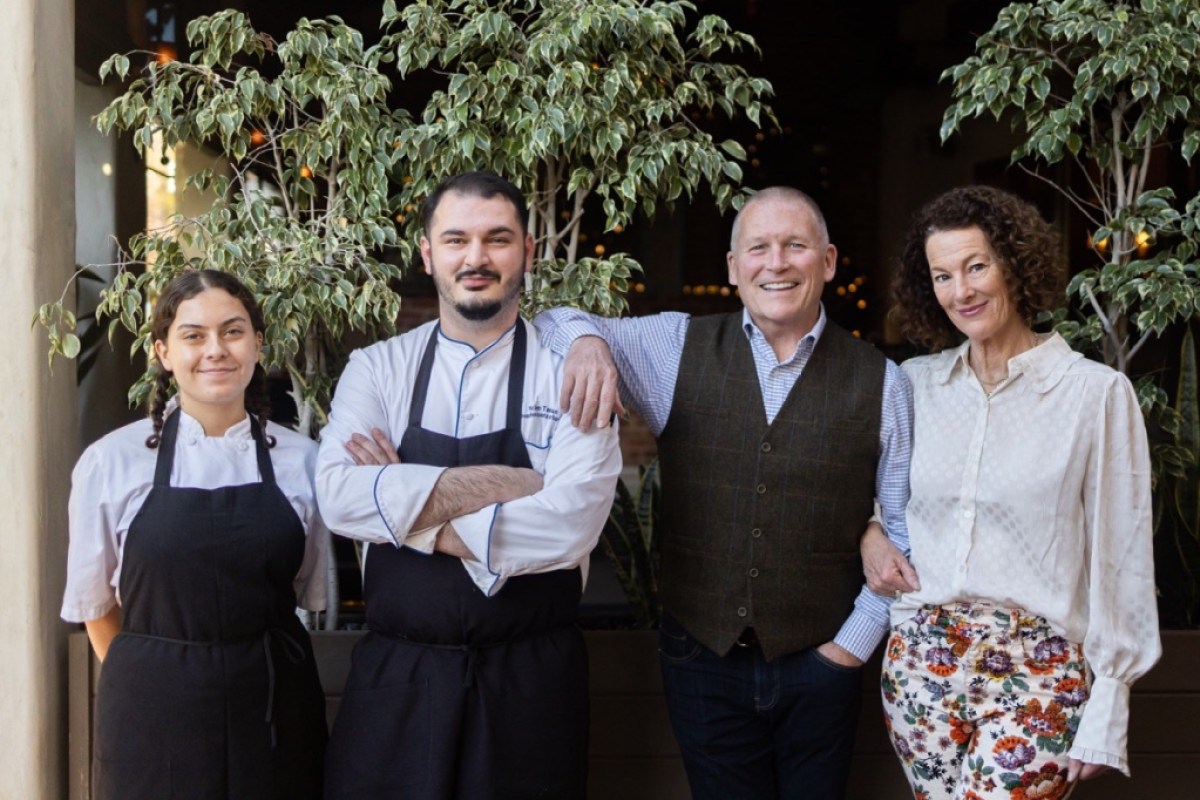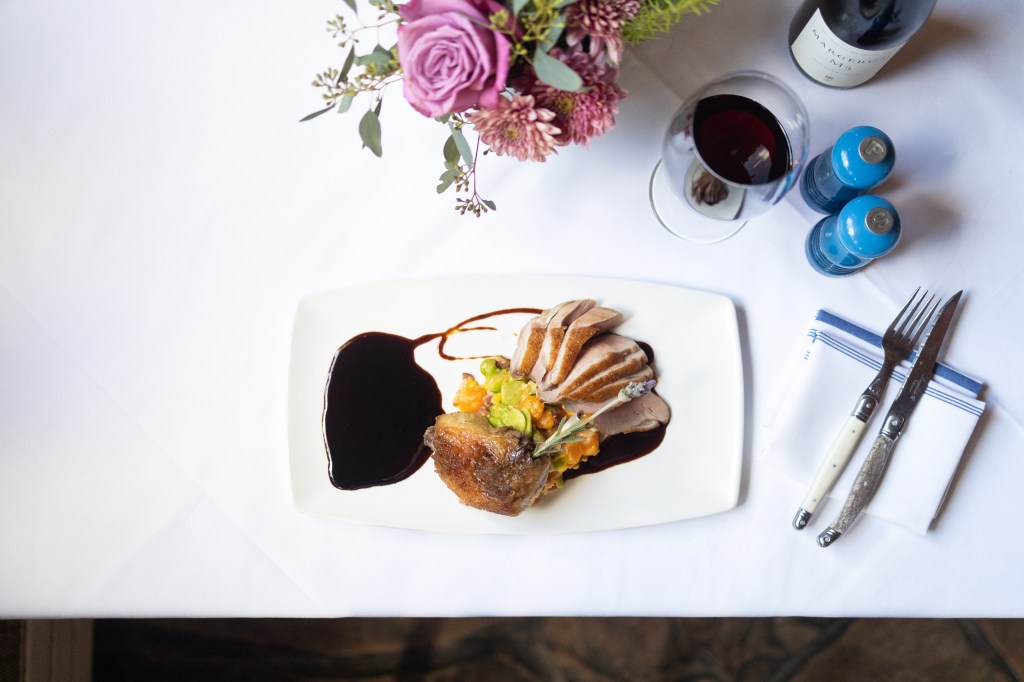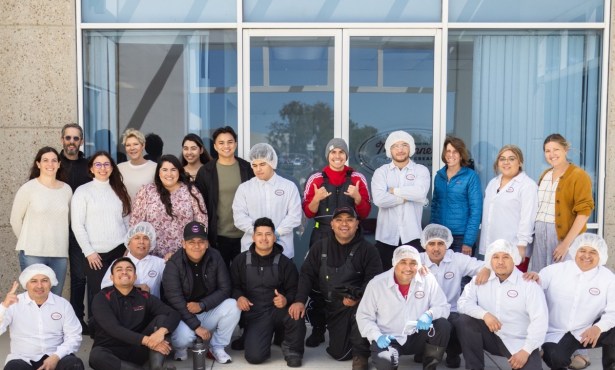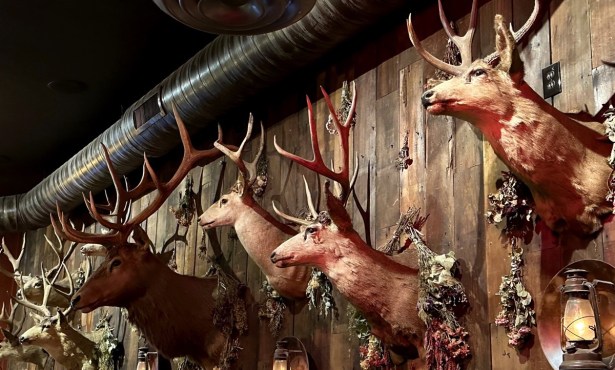bouchon’s Quarter-Century
of Santa Barbara
Wine Country Cuisine
Veteran Proprietor Mitchell Sjerven
Reflects on Restaurant Longevity
By Matt Kettmann | February 15, 2024

Most of Mitchell Sjerven’s crystal ball was remarkably clear a quarter-century ago, when he opened bouchon as one of the first restaurants in America, perhaps the first outside of Napa Valley, to serve “wine country cuisine.”
With a decade-plus of hospitality experience at that point — teenage dishwashing days in Minnesota, waiter jobs in Montecito, even a brief co-ownership — Sjerven knew that he had to stay consistent, establish long-term relationships with farmers and winemakers, and fire on all cylinders all the time to succeed in Santa Barbara’s competitive scene. The formula still works, as bouchon, which opened on the edge of Victoria Court on Bastille Day 1998, is toasting its 25th anniversary through this summer.
“You can’t just hit one or two of the four most important pillars of success in business — you have to hit on all four,” explains Sjerven. “You can’t just sit back and go, ‘Well, my food’s great; they’ll come for that.’ Or, ‘I have a cool, jazzy environment; they’ll come for that.’ Or, ‘My cocktail program kicks ass; they’ll come for that.’ I don’t care what you’re doing; you have to offer it all: hospitality, food and beverage, ambiance, people. You have to nail all four.”

But parts of that crystal ball were cloudier, obscuring the extreme challenges to come. Following an introductory decade of relative calm — save for 9/11 — bouchon and the rest of Santa Barbara restaurants endured an onslaught of disasters: the 2008 recession; multiple wildfires, particularly the Thomas Fire, where devastation extended into the economy; the traumatic, freeway-shutting 1/9 Debris Flow; and then, of course, COVID and the ensuing societal changes, inflation and otherwise. “In a hyper-competitive market with super-slim margins, any Thomas Fire or Debris Flow or COVID could knock you out in a second,” said Sjerven.
How a “classic” like bouchon continues to thrive in a foodie world that constantly craves “new” is very much on Sjerven’s mind right now, as are the struggles of today and tomorrow. He reached out to me last fall, eager to download what he’s learned, what he’s concerned about, and what he thinks of the modern state of the Santa Barbara restaurant business. “My Dinner with Andre experience,” Sjerven wrote to me in an email. “Just you and I over a meal at bouchon, where you note it all and are the final arbiter of not only what constitutes ‘success,’ but whether bouchon has achieved it.”
So, on a cool night in November, I joined Sjerven in the appropriately stylish parklet that bouchon erected on West Victoria Street during the pandemic. Over bottles of Louis Roederer rosé champagne, Delas Hermitage, and paired sips of Chanin chardonnays, we shared the last serving of that season’s tiger fig, burrata, and herb salad; the trio of scallops, of course, because it’s a bouchon flagship dish; the succulent pepper-crusted venison loin atop a sweet corn-saffron puree; and the steak au poivre with perfect potatoes au gratin, a summer special that made the regular menu due to customer demand.
For about three hours, we talked about our lives, our jobs, the business of restaurants, the business of writing, and, most of all, the trajectory of Santa Barbara’s dining scene.
“Our biggest challenge now for the restaurant business in Santa Barbara is that, even when priced properly from a value perspective, most of the working class here just simply doesn’t have the disposable income,” said Sjerven. “When just hanging on with mortgages and rent, people can barely go out.”
Midwest to West Victoria
Mitchell Sjerven’s paths to both restaurants and Santa Barbara were rather direct. Though conceived in San Diego, where his educator parents met at college, he was born in Minnesota, where they’d moved to be close to an ailing grandfather. Every summer, they’d load up the station wagon and drive to see his mom’s parents in Ventura.
“It was extraordinarily impactful for me, even at a young age, to come visit my grandparents, and then they retired to Carpinteria,” said Sjerven, who started plotting a move to California during those sunburned, tank-topped days. “By the time I was 12, it was clear.”
He worked as a dishwasher, prep cook, busboy, and server in high school, then came to UCSB in 1986. While studying international relations with an emphasis in French, Sjerven got his first Santa Barbara waiter job at Andria’s Harborside on Cabrillo Boulevard. During his junior year, he moved in with his grandmother in Carp after his grandfather died, commuting to school and work as a waiter at Piatti in Montecito on his Kawasaki 750 Spectre motorcycle. (Piatti is also where he met Amy Sachs, whom he’d later marry in 2000.)

His last semester of school was spent abroad interning with the European Parliament in Brussels, Belgium, where he hatched a plan to open a Tex-Mex concept in Liege with restaurant-owning friends. But as he worked in their busy French bistro, he realized they didn’t have the bandwidth to open something new. So he moved back to Santa Barbara, working at Wine Cask and then Acacia on Coast Village Road, where he became GM in 1995.
The next year, he opened Meritage on De la Vina Street with a partner, who amicably bought out Sjerven when they realized there wasn’t enough business to support them both. Ready to go for it on his own — “that was really important for me, to avoid partners and be in control” — he heard that the popular seafood spot Oysters was on the market, so he swooped into action, taking over the cozy indoor-outdoor location to open bouchon with Sachs in 1998.
It’s hard to believe that the now-common descriptor “wine country cuisine” was a foreign concept back then. “I was acutely aware of it in the beginning because people would ask, ‘What’s that?’” said Sjerven, who was also the first to showcase Santa Barbara County wines as the stars of the menu. Most restaurants were just serving the same distributor-crafted wine lists, and the Wine Cask restaurant — though its adjacent shop was a critical early champion of the region — focused more on established wines from the wider world.
“I didn’t feel like anybody was really doing exactly what we’re doing,” said Sjerven. “Far and away, that’s because the local wine scene wasn’t properly represented.”
The times were decidedly different back then, at least economically. “There was more disposable income, more of a dining-out culture,” he recalled. “When the servers would get off work, they’d go to Paradise — and you’d have to wait outside, it was so packed. That was a big difference.”
Consistency con Change
Adjustments have been made, especially as American fine dining increasingly embraced comfort over formality. Sjerven remembers one day in the restaurant’s early days when three separate parties arrived in casual wear, saw his suit and tie, and then left, thinking they weren’t properly attired. He started wearing jeans instead, occasionally opting for a fancier vest on weekends. Along with that shift to casual came a desire for dishes to be served faster, which remains challenging for a restaurant that truly serves everything to order.
But most of the original bouchon formula remains in place: a strong, dedicated chef, currently Vicken Tavitian, who became head chef in 2022; meticulous yet never overbearing service, overseen by manager Eric Hanson, who joined the team in 2006 and also manages the wine selection; and a reliance on fresh ingredients purchased straight from farmers.
That last leg of the stool can be witnessed up close during the weekly “Market Tour & Gourmet Dinner” packages. For $150 each, customers tour the farmers’ market with the chef on either Tuesday afternoon or Saturday morning and then gather at the restaurant to enjoy what was purchased through a three-course, wine-paired dinner, typically with plenty of extra flourishes.

“That’s my favorite single marketing tool,” said Sjerven, who launched that program when the restaurant opened. “It’s aspirational marketing. If a million people see that and only two of them did it, that’s cool. But then the other 999,998 think, ‘That’s the restaurant that I’d like to go to.’ It just tells the story. That’s who we are.”
Beyond that, the entire marketing and media landscape for restaurants in 2024 is astonishingly different from 1998. Social media — specifically the bevy of apps like Yelp, Tripadvisor, and OpenTable — rules the scene when it comes to putting butts in seats, and bouchon excels on all three of those, just this past Valentine’s Day being touted as one of the most romantic restaurants in America by the users of OpenTable and currently ranking as number two on Tripadvisor out of 299 Santa Barbara establishments.
Food journalism, however, is harder to control. Sjerven laments the loss of so many traditional publications, which has given way to “cut-and-paste” articles and listicles almost entirely about what’s new rather than what’s actually good. “They’re looking for the most esoteric thing, like a pop-up that’s only open on Tuesdays at midnight, trying to be the coolest kid on the block and get the most likes,” said Sjerven. “You end up with 150 articles in the last three months about Santa Barbara that all have the exact same three restaurants, because they all just opened. That’s a disservice to those restaurants that are tried and true.”
He much prefers the days when newspapers and magazines had the budgets to pay for professional critics who assessed quality. “You can be the newest, hottest restaurant for a year, and then it’s gonna move on, and you’re left with nothing,” said Sjerven. “If you’re coming out new and swinging for the fences, go for it. But as an established restaurant, I’m not for that.”
To him, the buzz that dominates the mediascape — from articles to influencers to word-of-mouth among self-proclaimed foodies — is really only speaking to maybe 10 percent of the people who regularly eat out. “Twenty-five years in, and we have guests who have returned 20, 50, even 100-plus times,” said Sjerven. “So it’s clear that they are not looking for the next new shiny, pretty toy, but rather are after that credible comfort.”
Storms on Horizon
Sjerven has branched out from bouchon a couple of times over the years, including his high-end seafood concept Seagrass, which he opened on the corner of Anacapa and Ortega in 2007 and sold in 2010, and his partnership in the resurrection of the Wine Cask from 2009 to 2017. More recently, he was planning to open a large private dining and event space above bouchon, but he realized that there weren’t enough available employees to staff the space.
Of all the restaurateurs in town, Sjerven would know, since he’s been a teacher in SBCC’s culinary program for 15 years.The labor market has never been worse for restaurants, which have been reeling in the post-pandemic era due to a smorgasbord of pressures, from toxic workplace environments to higher costs on everything to criticism over low wages and tip dispersal.
“Everybody knows this, but the back of the house is woefully underpaid, and that can’t be fixed in wages,” said Sjerven. “If I paid everybody $100,000 a year so they could afford to buy a house in Santa Barbara, burgers would be $112. You’d be out of business in a week. The model doesn’t work that way.”
Historically, entry-level jobs could lead to an actual career. “Maybe it’s just me as a 15-year-old dishwasher/prep cook speaking, but many of these jobs are intended to get a foothold in the industry and work your way up,” said Sjerven. “The fact that you can’t do that anymore isn’t because restaurants don’t pay enough. It’s because there isn’t affordable housing. You can’t earn your way out of that problem. If apartment rent is $3,000, that’s just untenable.”
It’s created an employment epidemic. “Most restaurants I know are struggling to find one extra kitchen staff or a busser or whatever — and literally, I’m talking about like every restaurant,” said Sjerven. “There just aren’t the people. That’s really the biggest single challenge going forward. How do you open a new enterprise and hope to find staff?”
Those who can solve that riddle would be wise to follow the lessons of Sjerven. By any measure I can think of, bouchon remains a success story in a region where restaurant failures exponentially outnumber the fairytales. But achieving happily ever after seems increasingly remote for restaurants unless Santa Barbara’s housing needs are addressed.
“My parents were teachers — they didn’t have any money; they didn’t give me any money to do this,” explained Sjerven. “That’s how you work your way up in this business: You start somewhere in the front of the house or the back of the house; you learn how the business works. If you have a dream and desire, you put the two together, you open your own place, and you move forward. In order to attract talent and workers to your enterprise, you need for them to be able to have a place to live. We don’t have that anymore.”




You must be logged in to post a comment.